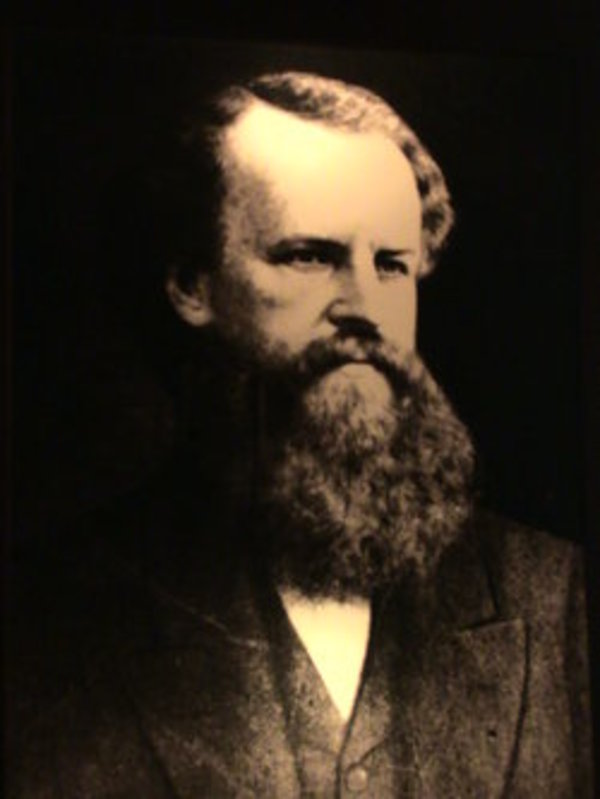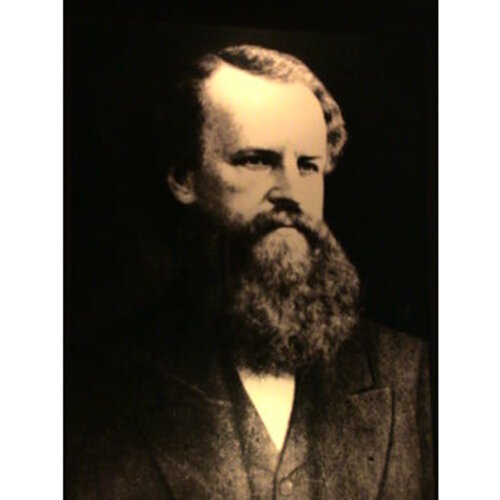
Source: Link
CAMERON, JOHN (known as Cariboo Cameron; also known as John A. Cameron), prospector; b. 1 Sept. 1820 in Charlottenburg Township, Glengarry County, Upper Canada, son of Angus Cameron and Isabella McDougal; m. first 20 Feb. 1860 Margaret Sophia Groves; m. secondly 1 March 1865 Christina Adelaide Wood; d. 7 Nov. 1888 at Barkerville, B.C.
John Cameron spent much of his early life in Glengarry County. In the 1850s he was in California, apparently as a prospector, but had returned to Glengarry by 1860. When gold was discovered that year in the Cariboo district of the British Columbia interior, Cameron decided to go there. He arrived at Victoria, Vancouver Island, in February 1862 with his wife and an infant daughter who died soon after. In Victoria, Cameron met Robert Stevenson, another native of Glengarry County, who backed him in his first venture in British Columbia, that of transporting supplies into the Cariboo gold district. Cameron was also a partner in a small company which in August staked a claim on Williams Creek in the Cariboo – the famous Cameron Claim.
On 22 Dec. 1862 the miners on the Cameron Claim “struck it very rich at 22 feet.” The claim soon became one of the largest operations in the Cariboo district and its success made Cameron a wealthy man. But prior to the strike, on 23 October, Margaret Sophia Cameron had died of typhoid fever and Cameron was determined to take his wife’s body back to Canada West for burial. On the last day of January 1863 Cameron and Stevenson, escorted for a time by other miners, set out on a gruelling 400-mile journey to Victoria, hauling Sophia’s body on a toboggan. They reached Victoria on 7 March and the body was buried there in an alcohol-filled coffin, pending its removal to the east. Cameron then returned to Williams Creek where he spent the summer working his claim.
In October 1863 Cameron left the Cariboo and, taking the coffin with him, travelled by way of the Isthmus of Panama and New York, reaching Cornwall, Canada West, before the end of the year. In December he had the coffin reburied. In March 1865 Cameron married Christina Adelaide Wood of Osnabruck Township and in July he laid the cornerstone of his imposing new residence, Fairfield House, at Summerstown in Glengarry County. In this period of prosperity, Cameron’s often rash behaviour, extravagance, and arrogance tended to foster hostile speculation on how he had obtained his fortune. This speculation included references to the first Mrs Cameron, and there was much gossip about the contents of the mysterious sealed coffin. It was even suggested that an appearance of death was contrived and that Cameron had actually sold his wife to an Indian chief for gold. In 1873, more than ten years after his first wife’s death, Cameron could bear his tormentors no longer and had the coffin raised. The face of Mrs Cameron, almost perfectly preserved in the alcohol, was exposed to the scrutiny of the public.
His windfall melted away, Cameron returned to British Columbia in 1886 or 1887. He died a poor man at Barkerville, the scene of his gold-mining success, and was buried nearby in the cemetery at Camerontown, a village named after him.
AO, MU 535, Cornwall, St John’s Presbyterian; MU 539, Williamstown, St Andrew’s Presbyterian; RG 8, I-6-B, 65. PABC, Add. mss 6, Francis Dickie, “‘Cariboo’ Cameron’s funerals’ saga, with suggested amendments, &c by Duncan Cameron” (typescript); Add. mss 315, Robert Stevenson diary and memo book, 1863–76 (copy); [James Cumming], “John A. (‘Cariboo’) Cameron”; GR 216, 34–41. PAC, MG 24, I3, 14: 14–15, 462, 808, 813–14, 825, 839–40. [W. B. Cheadle], Cheadle’s journal of trip across Canada, 1862–1863, ed. A. G. Doughty and Gustave Lanctot (Ottawa, 1931), 244, 249. Viscount [W. F.] Milton and W. B. Cheadle, The north-west passage by land: being the narrative of an expedition from the Atlantic to the Pacific . . . (6th ed., London, [1865]; repr. Toronto, 1970), 360, 373. Advertiser (Cornwall, [Ont.]), 12 July 1865. British Columbian (New Westminster, B.C.), 21 March, 18 April, 2 May, 6 June, 1, 5 Aug., 21 Oct. 1863. Cornwall Standard (Cornwall, Ont.), 24 April 1903. Daily British Colonist (Victoria), 28 Feb. 1862; 9 March, 7 Sept., 21, 22, 28 Oct. 1863. Daily Union (Ottawa), 2 March 1865. Freeholder (Cornwall), 15, 22 Dec. 1865. Glengarry News (Alexandria, Ont.), 16 Nov. 1928. Mainland Guardian (New Westminster), 10 Nov. 1888. Montreal Herald, 26 Aug. 1873. H. H. Bancroft, History of British Columbia, 1792–1887 (San Francisco, 1887). J. G. Harkness, Stormont, Dundas and Glengarry: a history, 1784–1945 (Oshawa, Ont., 1946), 405–8. W. P. Morrell, The gold rushes (2nd ed., London, 1968). Ormsby, British Columbia. W. W. Walkem, Stories of early British Columbia (Vancouver, 1914), 243–87. Charles Clowes, “Cariboo Cameron: a true saga of the romantic west,” Maclean’s (Toronto), 49 (1936), no.1: 26, 28, 30. A. D. Kean, “Dragged body on toboggan 320 miles, took 47 days,” Toronto Daily Star, 31 March 1934. Robert Stevenson, “The true story of the death of ‘Cariboo’ Cameron’s wife,” B.C. Saturday Sunset (Vancouver), 3 April 1909: 5, 14.
Cite This Article
Royce MacGillivray, “CAMERON, JOHN (1820-88) (Cariboo Cameron, John A. Cameron),” in Dictionary of Canadian Biography, vol. 11, University of Toronto/Université Laval, 2003–, accessed January 1, 2026, https://www.biographi.ca/en/bio/cameron_john_1820_88_11E.html.
The citation above shows the format for footnotes and endnotes according to the Chicago manual of style (16th edition). Information to be used in other citation formats:
| Permalink: | https://www.biographi.ca/en/bio/cameron_john_1820_88_11E.html |
| Author of Article: | Royce MacGillivray |
| Title of Article: | CAMERON, JOHN (1820-88) (Cariboo Cameron, John A. Cameron) |
| Publication Name: | Dictionary of Canadian Biography, vol. 11 |
| Publisher: | University of Toronto/Université Laval |
| Year of publication: | 1982 |
| Year of revision: | 1982 |
| Access Date: | January 1, 2026 |



